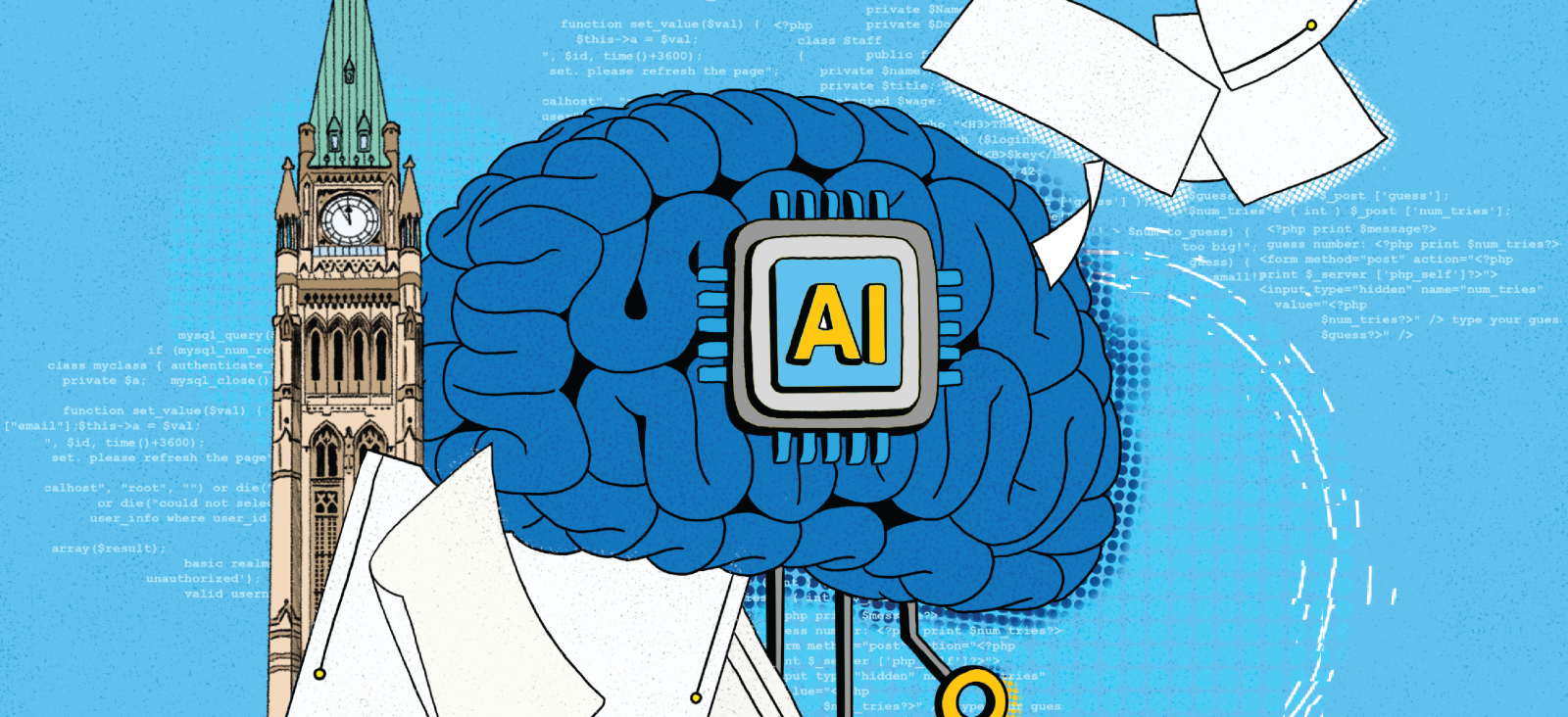Contributors

The Dais at the Toronto Metropolitan University

The Centre for Media, Technology and Democracy at McGill University
November 2023

1
Tessono, Christelle, Yuan Stevens, Momin Malik, M., Sonja Solomun, Supriya Dwivedi, and Sam Andrey. AI Oversight, Accountability and Protecting Human Rights. Cybersecure Policy Exchange, 2022.
https://www.cybersecurepolicy.ca/aida.
2
Tessono, Christelle, Yuan Stevens, Momin Malik, M., Sonja Solomun, Supriya Dwivedi, and Sam Andrey. AI Oversight, Accountability and Protecting Human Rights. Cybersecure Policy Exchange, 2022.
https://www.cybersecurepolicy.ca/aida.
3
International Civil Liberties Monitoring Group. “Canadians deserve to be protected from AI overreach, but Bill C-27’s Artificial Intelligence and Data Act is not up to the task.” September 25, 2023. https://iclmg.ca/aida-not-up-to-task/.
4
Learning Together for Responsible Artificial Intelligence: Report of the Public Awareness Working Group. Ottawa: Innovation, Science and Economic Development Canada Innovation, sciences et développement économique Canada, 2022.
5
See Women’s Legal Education and Action Fund. “Submission to the House of Commons Standing Committee on Industry & Technology”. 2023. https://www.ourcommons.ca/Content/Committee/441/INDU/Brief/BR12579508/br-external/WomensLegalEducationAndActionFund-e.pdf, Brandusescu, Ana and Renée Sieber. “Canada’s Artificial Intelligence and Data Act: A missed opportunity for shared prosperity”. 2023. https://www.ourcommons.ca/Content/Committee/441/INDU/Brief/BR12636987/br-external/Jointly4-e.pdf, Bailey, Jane., Burkell, Jacquelyn and Brenda McPhail. “Submissions on Bill C-27 The Digital Charter Implementation Act”. 2023. https://www.ourcommons.ca/Content/Committee/441/INDU/Brief/BR12605252/br-external/Jointly3-e.pdf, International Civil Liberties Monitoring Group. “Brief on Bill C-27”. 2023. https://www.ourcommons.ca/Content/Committee/441/INDU/Brief/BR12598706/br-external/InternationalCivilLibertiesMonitoringGroup-e.pdf, Attard-Frost, Blair. “Generative AI Systems: Impacts on Artists & Creators and Related Gaps in the Artificial Intelligence and Data Act”. 2023. https://www.ourcommons.ca/Content/Committee/441/INDU/Brief/BR12541028/br-external/AttardFrostBlair-e.pdf
6
For discussion on intellectual property theft from generative AI systems, see Attard-Frost, Blair. “Generative AI Systems: Impacts on Artists & Creators and Related Gaps in the Artificial Intelligence and Data Act”. 2023. https://www.ourcommons.ca/Content/Committee/441/INDU/Brief/BR12541028/br-external/AttardFrostBlair-e.pdf.
7
Fair, Lesley. “FTC’s $5 Billion Facebook Settlement: Record-Breaking and History-Making.” Federal Trade Commission, July 24, 2019. https://www.ftc.gov/business-guidance/blog/2019/07/ftcs-5-billion-facebook-settlement-record-breaking-and-history-making.
8
See Gray, Mary L., and Siddharth Suri. Ghost Work: How to Stop Silicon Valley from Building a New Global Underclass. Boston: Houghton Mifflin Harcourt, 2019., Li, Hanlin, Nicholas Vincent, Stevie Chancellor, and Brent Hecht. “The Dimensions of Data Labor: A Road Map for Researchers, Activists, and Policymakers to Empower Data Producers,” 1151–61, 2023., Newton, Casey. “The Secret Lives of Facebook Moderators in America.” The Verge, February 25, 2019. https://www.theverge.com/2019/2/25/18229714/cognizant-facebook-content-moderator-interviews-trauma-working-conditions-arizona.
9
Williams, Adrienne, Milagros Miceli., & Timnit Gebru. “The Exploited Labor Behind Artificial Intelligence.” Noema Magazine (2022). https://www.noemamag.com/the-exploited-labor-behind-artificial-intelligence/.
10
The CPPA would apply here as well, but with regards to AIDA, s.38
11
Lightbound, Joël. Standing Committee on Industry and Technology. 2023. https://www.ourcommons.ca/content/Committee/441/INDU/WebDoc/WD12600809/12600809/MinisterOfInnovationScienceAndIndustry-2023-10-03-e.pdf.
12
Stark, Luke and Jevan Hutson. “Physiognomic Artificial Intelligence”, Fordham Intell. Prop. Media & Ent. L.J. 32, no. 4 (2022). https://ir.lawnet.fordham.edu/iplj/vol32/iss4/2.
13
Tessono, Christelle, Yuan Stevens, Momin Malik, M., Sonja Solomun, Supriya Dwivedi, and Sam Andrey. AI Oversight, Accountability and Protecting Human Rights. Cybersecure Policy Exchange, 2022. https://www.cybersecurepolicy.ca/aida. p.17
14
AIDA, s.4(b)
15
Lyon, David and David Murakami Wood. Big Data Surveillance and Security Intelligence. UBC Press, 2020. https://www.ubcpress.ca/big-data-surveillance-and-security-intelligence.
16
Directive on Automated Decision-Making, 2019. https://www.tbs-sct.canada.ca/pol/doc-eng.aspx?id=32592.
17
Scassa, Teresa. “Comments on the Third Review of Canada’s Directive on Automated Decision-Making.” Teresa Scassa, May 17, 2022. https://www.teresascassa.ca/index.php?option=com_k2&view=item&id=354.
18
Office of the Privacy Commissioner of Canada. “PIPEDA Findings #2021-001: Joint Investigation of Clearview AI, Inc. by the Office of the Privacy Commissioner of Canada, the Commission d’accès à l’information Du Québec, the Information and Privacy Commissioner for British Columbia, and the Information Privacy Commissioner of Alberta,” February 2, 2021. https://www.priv.gc.ca/en/opc-actions-and-decisions/investigations/investigations-into-businesses/2021/pipeda-2021-001/.
19
Public Safety Canada. “Facial Verification at the Border,” January 19, 2022. https://www.publicsafety.gc.ca/cnt/trnsprnc/brfng-mtrls/prlmntry-bndrs/20211015/16-en.aspx.
20
Cardoso, Tom. “National Defence Skirted Federal Rules in Using Artificial Intelligence, Privacy Commissioner Says” The Globe and Mail, February 7, 2021. https://www.theglobeandmail.com/canada/article-national-defence-skirted-federal-rules-in-using-artificial/.
21
Artificial Intelligence and Data Act (AIDA) s.5 in Bill C-27, An Act to enact the Consumer Privacy Protection Act, the Personal Information and Data Protection Tribunal Act and the Artificial Intelligence and Data Act and to make consequential and related amendments to other Acts, 1 sess., 44th Parliament, 2022.
22
AIDA, s.5
23
Accessible Law. “Article 7: Amendments to Annex III.” https://artificialintelligenceact.com/title-iii/chapter-1/article-7/
24
Innovation, Science and Economic Development Canada. “The Artificial Intelligence and Data Act (AIDA) – Companion Document.” March 13, 2023. https://ised-isde.canada.ca/site/innovation-better-canada/en/artificial-intelligence-and-data-act-aida-companion-document.
25
OECD. “Creating a Culture of Independence: Practical Guidance Against Undue Influence.” https://www.oecd.org/gov/regulatory-policy/Culture-of-Independence-Eng-web.pdf.
26
Raji, Inioluwa Deborah, Peggy Xu, Colleen Honigsberg, and Daniel Ho. “Outsider Oversight: Designing a Third Party Audit Ecosystem for AI Governance.” In Proceedings of the 2022 AAAI/ACM Conference on AI, Ethics, and Society, 557–71. Oxford United Kingdom: ACM, 2022. https://doi.org/10.1145/3514094.3534181.